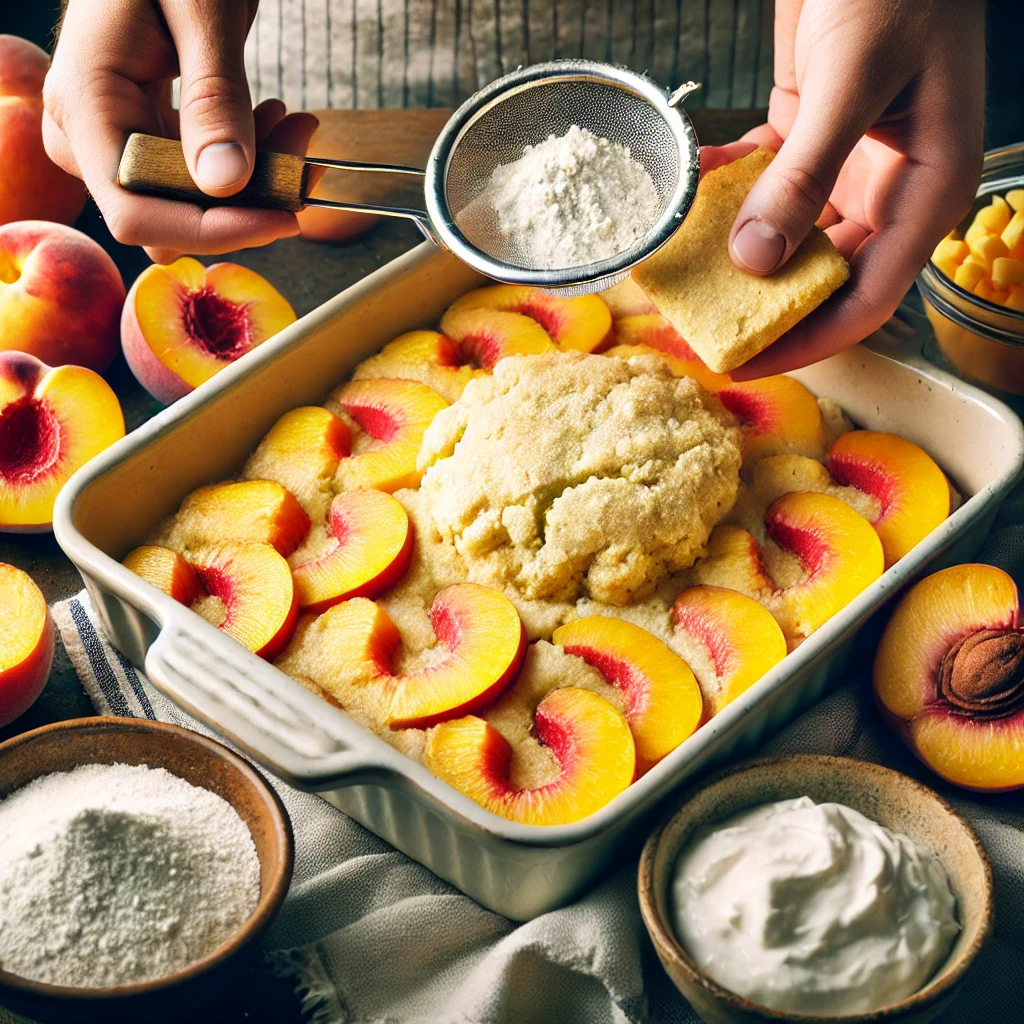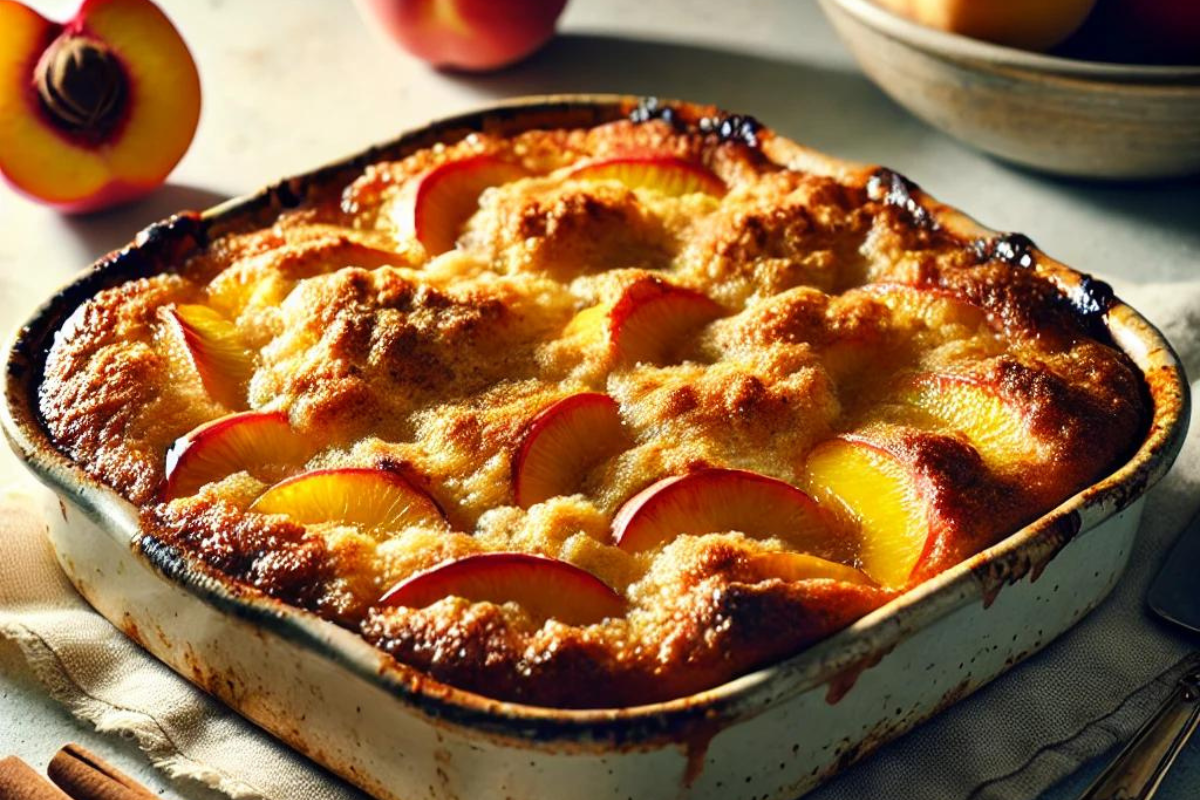Peach cobbler is a delicious dessert, but many bakers struggle with how to keep peach cobbler from getting soggy. A perfectly baked cobbler should have a juicy filling without being overly watery, and using the right techniques will help prevent soggy peach cobbler and ensure a crispy topping every time.
Common Reasons for Soggy Peach Cobbler

Before jumping into solutions, it’s important to understand why peach cobbler becomes soggy. Here are the most common causes:
- Overripe peaches: These tend to release too much liquid during baking.
- Too much liquid in the filling: Either from the peaches themselves or from additional sweeteners like sugar.
- Improper baking techniques: Not baking the cobbler long enough or at the right temperature can lead to a doughy and soggy topping.
Peach Variety Selection
Using the right type of peach can make all the difference in keeping your cobbler from becoming soggy. There are several factors to consider:
- Fresh peaches: When using fresh peaches, select firm peaches that are just ripe. Softer, overripe peaches release more moisture, leading to sogginess. You can check out this guide for more information on whether to use fresh or canned peaches.
- Canned peaches: When using canned peaches, always drain the liquid thoroughly to avoid excess moisture.
- Frozen peaches: Allow frozen peaches to thaw completely and drain any liquid that accumulates during the thawing process.
Techniques to Prevent Sogginess
There are several techniques you can use to ensure your cobbler stays crisp:
- Drain peaches well: Whether using fresh, frozen, or canned peaches, always drain any excess juice.
- Pre-cook the filling: Pre-cooking the peach filling helps reduce moisture before adding the topping. This is especially useful for very juicy peaches.
- Add a thickener: Incorporating a thickening agent like cornstarch or flour into your peach mixture can absorb extra liquid, preventing a runny cobbler. For more tips on how to manage moisture in other desserts, you can explore this guide on keeping pound cake from being dry.
Using Thickeners in the Filling

One of the most effective ways to keep your cobbler from becoming watery is by using thickeners. Here are a few options:
- Cornstarch: Adding 1-2 tablespoons of cornstarch helps absorb extra liquid and gives the filling a gel-like consistency.
- Flour: All-purpose flour can also work, though it may not be as effective as cornstarch.
- Tapioca: This is another great thickening agent that provides a smooth and gel-like texture to your filling.
Adjusting Sugar to Prevent a Runny Peach Cobbler
Sugar plays a significant role in the cobbler’s texture. Too much sugar draws out more juice from the peaches, which can make your cobbler too watery. Here are some tips for managing sugar levels:
- Use less sugar: If your peaches are already sweet, consider reducing the sugar to minimize excess liquid.
- Balance sugar with thickeners: If you’re using a lot of sugar, make sure to add more thickener to absorb the extra moisture.
Proper Baking Techniques to Keep Peach Cobbler Crispy
Proper baking is crucial to avoiding sogginess. Follow these tips to ensure your peach cobbler bakes to perfection:
- Bake at a high temperature: Aim for 375°F to 400°F. The high temperature ensures the filling cooks quickly and the topping crisps without overcooking.
- Leave space for steam: When adding the topping, leave gaps for steam to escape. This will help prevent the topping from getting soggy.
- Check for doneness: Make sure the filling is bubbling, and the topping is golden brown before taking it out of the oven.
Cobbler Topping Variations

Your topping choice can also affect whether the cobbler stays crisp or becomes soggy. Two common topping styles include:
- Biscuit-style topping: This topping can become soggy if it’s too thick. To prevent this, make sure the biscuit topping is thin and cooks thoroughly.
- Cake-style topping: A lighter cake-like topping is less likely to trap moisture and can be a great option for maintaining a crisp texture.
For additional dessert topping ideas, you might want to check out this guide on versatile cream cheese desserts, which offers inspiration for different textures and flavors.
Allowing Cooling Time to Avoid a Watery Peach Cobbler
Proper cooling is another key to avoiding sogginess. After removing the cobbler from the oven, let it sit for at least 15-20 minutes. This allows the filling to set and prevents it from becoming too runny when served.
FAQs: People Also Ask
Why is my peach cobbler so watery?
Too much liquid from overripe peaches or improper baking can cause this. Using thickeners like cornstarch or pre-cooking the filling can help avoid this issue.
How do I thicken my peach cobbler filling?
Add 1-2 tablespoons of cornstarch or other thickening agents like flour or tapioca to your peach mixture before baking.
Can I freeze the peach cobbler without it getting soggy?
Yes, you can freeze the peach filling separately and add the topping when you’re ready to bake.
Should peach cobbler be runny?
No, peach cobbler should have a syrupy consistency but not be runny or watery.
Can you make a peach cobbler ahead of time without it getting soggy?
Yes, you can make the filling and topping separately and assemble them just before baking to avoid sogginess.
Conclusion: Crafting the Perfect Peach Cobbler
By using the right techniques — from selecting the proper peaches to incorporating thickeners and baking at the correct temperature — you can avoid the common issue of soggy peach cobbler. Whether you’re using fresh, canned, or frozen peaches, applying these strategies will ensure a crisp and delicious result every time.
For more baking tips and recipes, explore related articles like this perfect peach cobbler cheesecake recipe for additional inspiration!
